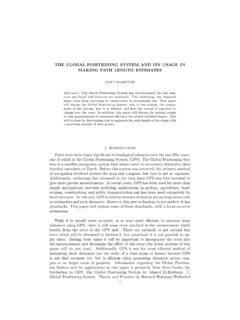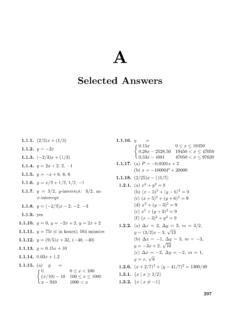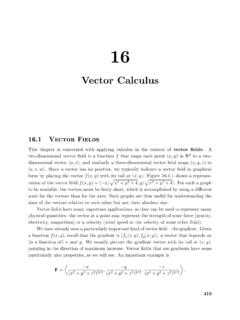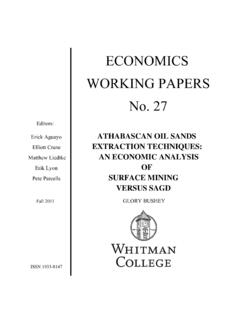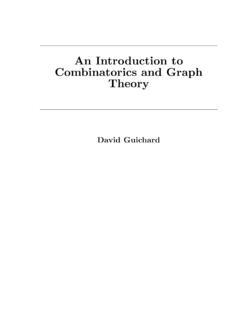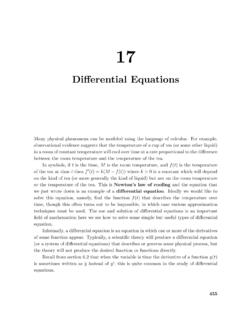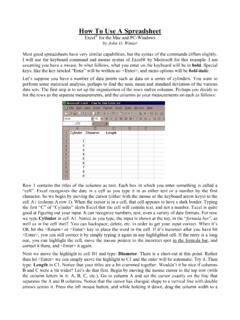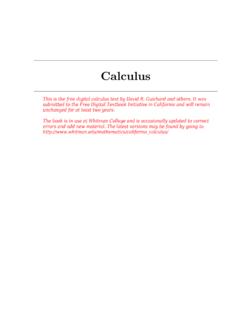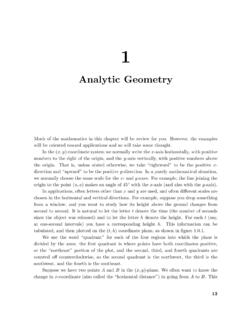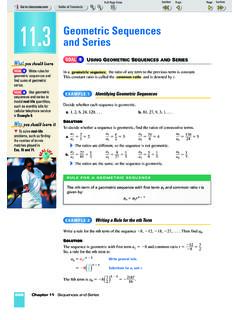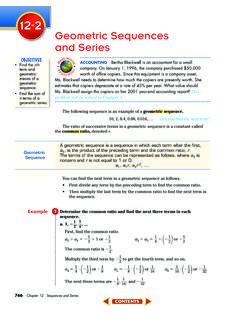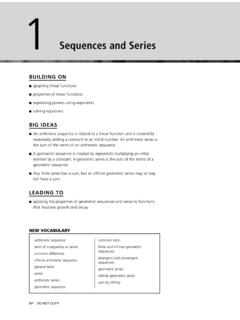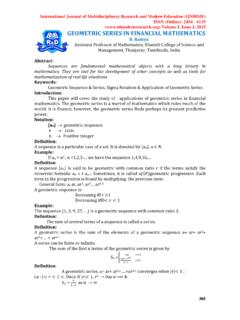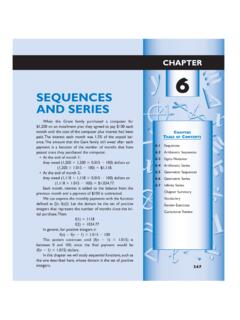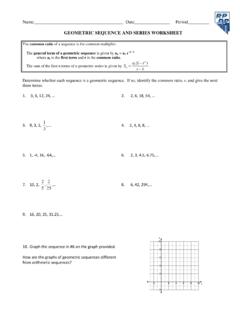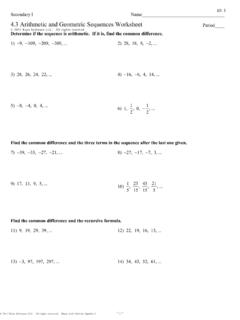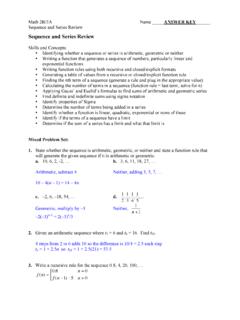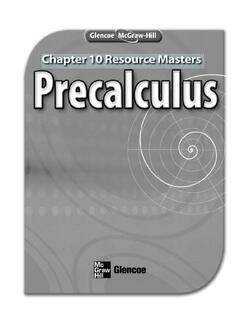Transcription of Sequences and Series - Whitman College
1 11 Sequences and SeriesConsider the following sum:12+14+18+116+ +12i+ The dots at the end indicate that the sum goes on forever. Doesthis make sense? Canwe assign a numerical value to an infinite sum? While at first itmay seem difficult orimpossible, we have certainly done something similar when we talked about one quantitygetting closer and closer to a fixed quantity. Here we couldask whether, as we add moreand more terms, the sum gets closer and closer to some fixed value. That is, look at12=1234=12+1478=12+14+181516=12+14+18+ 116and so on, and ask whether these values have a limit. It seems pretty clear that they do,namely 1. In fact, as we will see, it s not hard to show that12+14+18+116+ +12i=2i 12i= 1 12i255256 Chapter 11 Sequences and Seriesand thenlimi 1 12i= 1 0 = is one place that you have long accepted this notion of infinite sum without reallythinking of it as a 3 =310+3100+31000+310000+ =13,for example, ..= 3 +110+4100+11000+510000+9100000+ =.
2 Our first task, then, to investigate infinite sums, calledseries, is to investigate limits ofsequencesof numbers. That is, we officially call i=112i=12+14+18+116+ +12i+ a Series , while12,34,78,1516, .. ,2i 12i, ..is a sequence , and i=112i= limi 2i 12i,that is, the value of a Series is the limit of a particular esWhile the idea of a sequence of numbers,a1, a2, a3, ..is straightforward, it is useful tothink of a sequence as a function. We have up until now dealt with functions whose domainsare the real numbers, or a subset of the real numbers, likef(x) = sinx. A sequence is afunction with domain the natural numbersN={1,2,3, ..}or the non-negative integers,Z 0={0,1,2,3, ..}. The range of the function is still allowed to be the real numbers; insymbols, we say that a sequence is a functionf:N R. Sequences are written in a fewdifferent ways, all equivalent; these all mean the same thing:a1, a2, a3, ..{an} n=1{f(n)} n=1As with functions on the real numbers, we will most often encounter Sequences thatcan be expressed by a formula.
3 We have already seen the sequenceai=f(i) = 1 1/2i, Sequences257and others are easy to come by:f(i) =ii+ 1f(n) =12nf(n) = sin(n /6)f(i) =(i 1)(i+ 2)2iFrequently these formulas will make sense if thought of either as functions with domainRorN, though occasionally one will make sense only for integer with a sequence we are interested in the limitlimi f(i) = limi already understandlimx f(x)whenxis a real valued variable; now we simply want to restrict the input values to beintegers. No real difference is required in the definition of limit, except that we specify, per-haps implicitly, that the variable is an integer. Compare this definition to definition that{an} n=1is a sequence . We say that limn an=Lif for every >0 there is anN >0 so that whenevern > N,|an L|< . If limn an=Lwe say that the sequenceconverges, otherwise (i) defines a sequence , andf(x) makes sense, and limx f(x) =L, then it is clearthat limi f(i) =Las well, but it is important to note that the converse of this statementis not true.
4 For example, since limx (1/x) = 0, it is clear that also limi (1/i) = 0, that is,the numbers11,12,13,14,15,16, ..get closer and closer to 0. Consider this, however: Letf(n) = sin(n ). This is the sequencesin(0 ),sin(1 ),sin(2 ),sin(3 ), ..= 0,0,0,0, ..since sin(n ) = 0 whennis an integer. Thus limn f(n) = 0. But limx f(x), whenxisreal, does not exist: asxgets bigger and bigger, the values sin(x ) do not get closer and258 Chapter 11 Sequences and Seriescloser to a single value, but take on all values between 1 and 1 over and over. In general,whenever you want to know limn f(n) you should first attempt to compute limx f(x),since if the latter exists it is also equal to the first limit. But if for some reason limx f(x)does not exist, it may still be true that limn f(n) exists, but you ll have to figure outanother way to compute is occasionally useful to think of the graph of a the function isdefined only for integer values, the graph is just a sequence of dots.
5 In figure we seethe graphs of two Sequences and the graphs of the corresponding real (x) = 1/x0123450510 f(n) = 1/n (x) = sin(x ) 1011 2 3 4 5 6 7 8 f(n) = sin(n )Figure of Sequences and their corresponding real surprisingly, the properties of limits of real functions translate into properties ofsequences quite easily. Theorem about limits becomesTHEOREM that limn an=Land limn bn=Mandkis some kan=klimn an=kLlimn (an+bn) = limn an+ limn bn=L+Mlimn (an bn) = limn an limn bn=L Mlimn (anbn) = limn an limn bn=LMlimn anbn=limn anlimn bn=LM,ifMis not 0 Likewise the Squeeze Theorem ( ) Sequences259 THEOREM thatan bn cnfor alln > N, for someN. If limn an=limn cn=L, then limn bn= a final useful fact:THEOREM |an|= 0 if and only if limn an= says simply that the size ofangets close to zero if and only ifangets close whether{nn+ 1} n=0converges or diverges. If it con-verges, compute the limit. Since this makes sense for real numbers we considerlimx xx+ 1= limx 1 1x+ 1= 1 0 = the sequence converges to whether{lnnn} n=1converges or diverges.
6 If it con-verges, compute the limit. We computelimx lnxx= limx 1/x1= 0,using L H opital s Rule. Thus the sequence converges to whether{( 1)n} n=0converges or diverges. If it con-verges, compute the limit. This does not make sense for all real exponents, but the sequenceis easy to understand: it is1, 1,1, 1,1..and clearly whether{( 1/2)n} n=0converges or diverges. If it con-verges, compute the limit. We consider the sequence {|( 1/2)n|} n=0={(1/2)n} n=0. Thenlimx (12)x= limx 12x= 0,so by theorem the sequence converges to 11 Sequences and SeriesEXAMPLE whether{(sinn)/ n} n=1converges or diverges. If itconverges, compute the limit. Since|sinn| 1, 0 |sinn/ n| 1/ nand we can usetheorem withan= 0 andcn= 1/ n. Since limn an= limn cn= 0, limn sinn/ n=0 and the sequence converges to particularly common and useful sequence is{rn} n=0, for variousvalues ofr. Some are quite easy to understand: Ifr= 1 the sequence converges to 1 sinceevery term is 1, and likewise ifr= 0 the sequence converges to 0.
7 Ifr= 1 this isthe sequence of example and diverges. Ifr >1 orr < 1 the termsrnget largewithout limit, so the sequence diverges. If 0< r <1 then the sequence converges to 1< r <0 then|rn|=|r|nand 0<|r|<1, so the sequence {|r|n} n=0converges to0, so also{rn} n=0converges to 0. converges. In summary,{rn}converges precisely when 1< r 1 in which caselimn rn={0 if 1< r <11 ifr= 1 Sometimes we will not be able to determine the limit of a sequence , but we still wouldlike to know whether it converges. In some cases we can determine this even without beingable to compute the sequence is calledincreasingor sometimesstrictly increasingifai< ai+1foralli. It is callednon-decreasingor sometimes (unfortunately)increasingifai ai+1for alli. Similarly a sequence isdecreasingifai> ai+1for alliandnon-increasingifai ai+1for alli. If a sequence has any of these properties it is sequence {2i 12i} i=1=12,34,78,1516, .. ,is increasing, and{n+ 1n} i=1=21,32,43,54, ..is sequence isbounded aboveif there is some numberNsuch thatan Nfor everyn, andbounded belowif there is some numberNsuch thatan Nfor everyn.}
8 If asequence is bounded above and bounded below it isbounded. If a sequence {an} n=0isincreasing or non-decreasing it is bounded below (bya0), and if it is decreasing or non-increasing it is bounded above (bya0). Finally, with all this new terminology we can statean important Sequences261 THEOREM a sequence is bounded and monotonic then it will not prove this; the proof appears in many calculus books. It is not hard tobelieve: suppose that a sequence is increasing and bounded,so each term is larger than theone before, yet never larger than some fixed valueN. The terms must then get closer andcloser to some value betweena0andN. It need not beN, sinceNmay be a too-generous upper bound; the limit will be the smallest number that is above all of the of the terms (2i 1)/2iare less than 2, and the sequence isincreasing. As we have seen, the limit of the sequence is 1 1 is the smallest number thatis bigger than all the terms in the sequence . Similarly, all of the terms (n+1)/nare biggerthan 1/2, and the limit is 1 1 is the largest number that is smaller than the terms of don t actually need to know that a sequence is monotonic toapply this theorem it is enough to know that the sequence is eventually monotonic, that is, that at somepoint it becomes increasing or decreasing.
9 For example, thesequence 10, 9, 8, 15, 3, 21, 4,3/4, 7/8, 15/16, 31/32, ..is not increasing, because among the first few terms it is starting with the term 3/4 it is increasing, so the theorem tells us that the sequence3/4,7/8,15/16,31/32, ..converges. Since convergence depends only on what happens asngets large, adding a few terms at the beginning can t turn a convergent sequence into adivergent that{n1/n} first show that this sequence is decreasing, that is, thatn1/n>(n+1)1/(n+1). Considerthe real functionf(x) =x1/xwhenx 1. We can compute the derivative,f (x) =x1/x(1 lnx)/x2, and note that whenx 3 this is negative. Since the function has negativeslope,n1/n>(n+ 1)1/(n+1)whenn 3. Since all terms of the sequence are positive, thesequence is decreasing and bounded whenn 3, and so the sequence converges. (As ithappens, we can compute the limit in this case, but we know it converges even withoutknowing the limit; see exercise 1.)EXAMPLE that{n!/nn} we show that the sequence is decreasing, and since eachterm is positive the sequenceconverges.
10 We can t take the derivative this time, asx! doesn t make sense forxreal. Butwe note that ifan+1/an<1 thenan+1< an, which is what we want to know. So we lookatan+1/an:an+1an=(n+ 1)!(n+ 1)n+1nnn!=(n+ 1)!n!nn(n+ 1)n+1=n+ 1n+ 1(nn+ 1)n=(nn+ 1)n< 11 Sequences and Series (Again it is possible to compute the limit; see exercise 2.)Exercises limx x1/x. the squeeze theorem to show that limn n!nn= whether{ n+ 47 n} n=0converges or diverges. If it converges, compute thelimit. whether{n2+ 1(n+ 1)2} n=0converges or diverges. If it converges, compute the limit. whether{n+ 47 n2+ 3n} n=1converges or diverges. If it converges, compute thelimit. whether{2nn!} n=0converges or diverges. much more can be said about Sequences , we now turn to ourprincipal interest, Series . Recall that a Series , roughly speaking, is the sum ofa sequence : if{an} n=0is asequence then the associated Series is i=0an=a0+a1+a2+ Associated with a Series is a second sequence , called thesequence of partial sums{sn} n=0:sn=n i= , s1=a0+a1, s2=a0+a1+a2.
